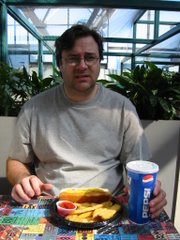Tuesday morning began with Jacques demonstrating to us how to de-bone an entire chicken while leaving the meat entirely intact. When done, you are left with a whole boneless chicken (the tip of the leg bones are left in for effect) which is ready to be stuffed, rolled, tied and roasted. After the chicken is roasted, you cut it across the body to produce beautiful medallions of boneless, stuffed chicken. It was cool.
Then it was into the kitchen and our turn to perform the same trick--and it is something akin to a magic trick. Everyone had the opportunity to de-bone at least one chicken. Needless to say, Jacques made it look a lot easier than it really is. Because the process requires making very precise cuts which need to be done the exact right order, I think everyone had at least one moment (if not more) of staring at a partially de-boned chicken trying to figure out what to do next. Fortunately, Jacques and Jean-Claude floated around showing us all what we were doing wrong. It was massively fun and, in the end, all of the two dozen or so chickens were successfully de-boned.
Jean-Claude gathered up all of the left over bones to make two stocks: one white and one brown. The brown stock became the base for a demi-glace sauce for the chicken, while the white stock became a base for a soup.
Meanwhile, Jacques gathered the livers and the soft fat from the inside of the breast to make a paté. The fat and the livers were cooked in duck fat (lots of duck fat) then pureed, strained and seasoned. The final product was completely decedent, but unbelievably good.
Both Tuesday and Wednesday culminated with Jacques doing a demonstration for 70 people of "Complete Techniques with Jacques Pépin." Each person attending got a sampling of food prepared by Jacques and Jean-Claude with our assistance. One thing about preparing food for 140 people, there are invariably some repetitive tasks that need to be performed: bread needs to be sliced, grapefruits need to be sectioned, carrots need to be peeled, etc. But this is how we learn. As a chef, you cannot really be proficient at something until you have done it so many times that it becomes second nature to you. The gap between Jacques' skill at boning a chicken and our skill at the same task is vast. But then he has done it so many times that he may literally not even think about what he is doing while he is doing it.
And this is where the classic techniques come into play. They are time-tested techniques that once mastered allow a chef to move efficiently but effectively through the kitchen. But, good technique is about the expression of skill versus the expression of talent.
Raw talent is undeniable, but good technique can be learned.
Think about it this way. Alex Rodriguez is the best hitter in baseball, this is in part because he has more natural talent than most if not all other baseball players. But, Alex probably hits hundreds, if not thousands, baseballs a day. This allows him to hone his skill, his technique. His talent is augmented by the continual development of his skill.
If you de-boned a dozen chickens every day for a month, you would get pretty good at it. The fact is, good cooking is in part a result of the familiarity that comes from repetition.
Anyway...
Jacques and Jean-Claude are both part of a dying breed of chefs who prepare traditional French cuisine with a stress on using classic techniques. You could say that they are "old School." In this age of globalization, cultural exchange and culinary fusion, it is admirable to see to someone who has essentially been preparing the same food in the same way for over fifty years. Classic, indeed.
 The week ended with a $500 a plate sit-down dinner. The menu was created by Jacques, literally. Not only did he choose the dishes on the menu, but he illustrated the menu itself. (You can see my signed version at the left.)
The week ended with a $500 a plate sit-down dinner. The menu was created by Jacques, literally. Not only did he choose the dishes on the menu, but he illustrated the menu itself. (You can see my signed version at the left.)The menu included:
Passed Hors D'oeuvre of:
Oysters Rockefeller
Clam Fritters with Tapenade
Smoked Trout with Scrambled Eggs
Dinner:
Potage Parmentier
Crispy Sweetbreads
Roasted Squab with pea and lettuce stew
Salade Santé with cheese and caramelized cashews
Chocolate tartlets with raspberry Sorbet and candied grapefruit peel.
Frankly, there is nothing on this menu that is startlingly original. But really, that is not the point. This meal, and really all of Jacques food, is about classic dishes prepared correctly. It is fun to eat food that titillates the mind, but really, it all comes down to whether it tastes good or not. This food tasted good.



























